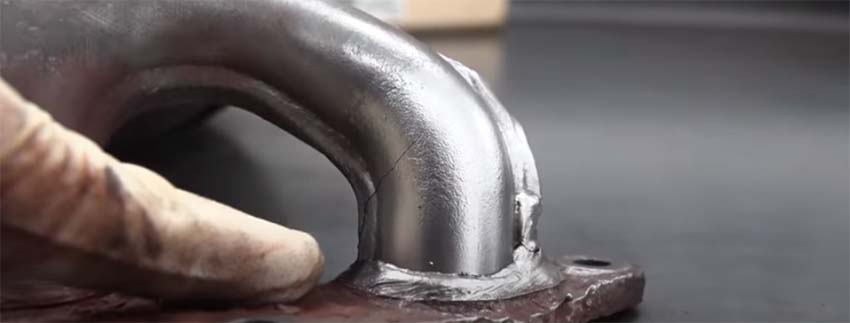The exhaust manifold is more than just an integral part of your vehicle’s engine. It acts as the crucial gateway that channels the exhaust gases generated by the engine’s combustion process from multiple cylinders into a single pipe. This pipe then directs these gases through the rest of the exhaust system, which includes the catalytic converter and the muffler, eventually expelling them out through the tailpipe. But its function doesn’t stop there. The exhaust manifold also plays an indispensable role in managing the engine’s temperature by effectively disposing of the hot exhaust gases. This temperature management is crucial to maintain the overall engine performance and prevent potential damage due to overheating. A quality exhaust manifold ensures your vehicle’s health, boosts its performance, and contributes to a smoother, more efficient driving experience.
Causes of Exhaust Manifold Cracks
Cracks in the exhaust manifold are typically a result of the extreme operating conditions the component is exposed to. The manifold is subjected to intense heat generated by the exhaust gases and substantial pressure from the engine’s combustion process. Over time, the relentless heating and cooling cycles that the manifold goes through can lead to metal fatigue, manifesting as small cracks. In addition to the thermal stress, the manifold also faces mechanical stress caused by the vibrations of the engine and the weight of the exhaust system itself. As if these factors weren’t enough, external elements like road salt during winters or moisture can speed up the corrosion process of the manifold material, potentially leading to cracks.
Detecting Cracks in the Exhaust Manifold
Given its somewhat concealed location, detecting cracks in the exhaust manifold can be a bit of a challenge. However, the presence of cracks can manifest in certain symptoms that indicate a potential issue. One common sign is an unusual ticking or tapping noise coming from the engine, especially noticeable during the initial engine start-up or when accelerating. Another indication is a perceptible decrease in engine performance or an unexplained increase in fuel consumption. Moreover, the escape of exhaust gases through the cracks can lead to a strong smell of exhaust gases permeating the engine bay or even the cabin. If you notice any of these symptoms, it’s advisable to conduct a thorough inspection of the exhaust manifold for any visible cracks or damage.

Consequences of Ignoring Exhaust Manifold Cracks
Choosing to ignore cracks in the exhaust manifold can lead to serious repercussions. For starters, these cracks create a path for the exhaust gases to escape prematurely. This means that harmful gases, including the deadly carbon monoxide, can leak into the engine bay and potentially find their way into the vehicle’s cabin, posing a severe health risk to the vehicle’s occupants. From a mechanical perspective, the escape of exhaust gases results in a loss of exhaust pressure. This disruption can negatively impact engine performance, causing reduced fuel efficiency and decreased power output. If left untreated over time, a cracked exhaust manifold can lead to collateral damage to other engine components due to the excessive heat and misplaced exhaust gases, culminating in expensive crack manifold repair or replacement costs.
How to Fix Crack in Exhaust Manifold
When it comes to addressing a cracked exhaust manifold, the repair process typically involves either welding the crack or replacing the manifold entirely. The best course of action largely depends on the size and location of the crack. Small cracks might be successfully repaired using a specialized repair kit, which involves applying a compound that can withstand high temperatures. However, this might not be an effective solution for larger cracks or cracks located in hard-to-reach areas. In such cases, the manifold may need to be replaced. It’s always best to consult with a professional mechanic who can accurately assess the situation and recommend the most appropriate solution for your specific vehicle.
Preventive Measures and Regular Maintenance
Prevention is always better than cure, and this adage holds true in the context of exhaust manifold cracks as well. By adopting certain preventive measures and adhering to a regular maintenance schedule, you can significantly reduce the chances of developing cracks in your exhaust manifold. Regular visual inspections of the exhaust manifold for signs of wear, corrosion, or small cracks can help catch issues early, before they turn into larger, more expensive problems.
Moreover, staying on top of your vehicle’s recommended maintenance schedule can also aid in preventing cracks. This includes timely oil changes, which help ensure smooth engine operation, and regular check-ups of the exhaust system. If your vehicle model allows it, opting for stainless steel or cast iron manifolds can offer greater resistance to cracking due to their enhanced durability.
Another important preventive measure is to avoid harsh driving conditions as much as possible, such as excessive acceleration or heavy towing, that can cause undue stress on the engine and exhaust system. If you live in an area with harsh winters, make sure to rinse the underside of your vehicle regularly to remove road salt, which can accelerate the corrosion of the exhaust manifold.
Finally, if you’re in the market for an upgrade or replacement, do your research to ensure you’re investing in quality components that can withstand the rigors of your vehicle’s operations. While the Best Exhaust System for GMC Sierra is a great choice for those specific models, the right system will depend on your particular vehicle make and model. Remember, investing in quality components now can save you a lot of time, money, and stress down the line.



